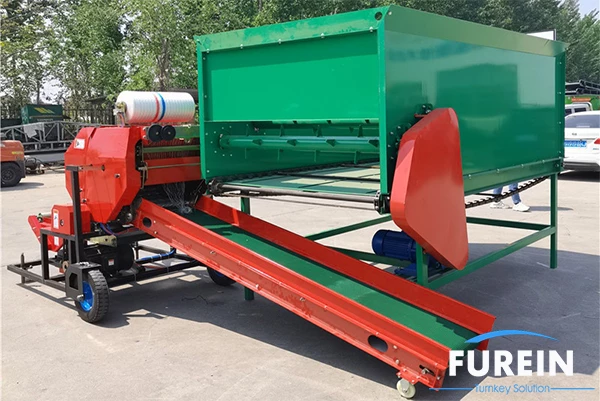Silage baler and wrapper machine
Silage baler and wrapper machine, also known as silage round baler, is a kind of agricultural machinery used to package fresh feeds such as grass, corn stalks into silage. It integrates the functions of baling and wrapping in one, and can automatically complete the process of cutting, compaction, baling and wrapping of fresh feed. Simple operation, high efficiency. Silage baler wrapper is one of the important equipment for modern animal husbandry production.

How does a silage baler and wrapper machine work?
The working principle of silage baler and wrapper machine is as follows:
- Feeding: Silage is fed into the baler through the belt machine.
- Compacting: The cut silage is compacted into round bales in the chamber.
- Baling: The outer layer will automatically pack 2-3 layers along with the breathable mesh to make the bale into a tight shape.
- Wrapping: The hay bales enter the wrapping device and are secured on the rotating turntable. The wrapping device pulls out the plastic film and wraps it tightly around the bale.
- Molding: When the wrapping film reaches a predetermined number of layers (2-3 layers), the straw bale can be molded.
- Discharge: Hydraulic plunger tilts the wrapping table so that the hay bale is turned down to complete the discharge.
Technical specification
When choosing a silage baler and wrapper machine, in addition to considering factors such as the model and function of the machine, the choice of power is also an important aspect. At present, the silage baler and wrapper machine on the market mainly has diesel models and electric models of two kinds, users can choose according to their own needs.
If you don't want an automatic wrapping machine, it's even more recommended to use a horizontal baling and bagging machine, which can produce twice as much as an automatic wrapping machine.
Here is a list of diesel and electric models of silage baler wrapper technical parameters, is the smallest model parameters for your reference, in addition, we also manufacture more and more big silage balers and wrapper machines, if you need please contact us.
Electric parameters

| Dimensions(L×W×H mm) | 3500×1500×1600 |
|---|---|
| Weight(kg) | 550 |
| Bale weight(kg) | 35-85kg/bale |
| Bale size(mm) | 550×520 |
| Loading conveyor belt(mm) | 500×1750 |
| Motor power(kw) | 5.5 / 0.55 / 1.1 |
| Capacity | 50-65 bale/h |
| Rated speed/min | 350 |
| Operation | Manual / Automatic |
| Grass silage film | 1800m×250mm×25um |
| Air pump volume(m³) | 0.17 |
| Strapping material | Hemp rope/ Net rope |
| Film layer | Distribution box PLC regulation |
| Film wrapping efficiency(bundle) | 18 circle/2 layer |
| 26 circle/3 layer | |
| 37 circle/4 layer | |
| Conveyor | Belt |
Diesel Parameters

| Dimensions(L×W×H mm) | 3500×1500×1600 |
|---|---|
| Weight(kg) | 550 |
| Bale weight(kg) | 35-85kg/bale |
| Bale size(mm) | 550×520 |
| Loading conveyor belt(mm) | 500×1750 |
| Diesel power | 15 HP |
| Capacity | 50-65 bale/h |
| Rated speed/min | 350 |
| Operation | Manual / Automatic |
| Grass silage film | 1800m×250mm×25um |
| Air pump volume(m³) | 0.17 |
| Strapping material | Hemp rope/ Net rope |
| Film layer | Distribution box PLC regulation |
| Film wrapping efficiency(bundle) | 18 circle/2 layer |
| 26 circle/3 layer | |
| 37 circle/4 layer | |
| Conveyor | Belt |
Features of Silage baler and wrapper machine
- Good sealing: The wrapped bales have good sealing, which can effectively prevent the silage from getting moldy and rotten and extend the storage time.
- Convenient transportation: The baled bales are small in size and light in weight, making transportation more convenient.
- Simple operation: only one person is required to complete the bundling, wrapping and other processes.
- High efficiency: The work efficiency is fast, which can greatly save labor. The circular baling and wrapping machine has high work efficiency and can generally tie 60 bundles per hour.
- Wide application: Suitable for various types of pasture and corn silage, meeting the needs of different users.
- Automatic packaging: Automatic feeding of conveyor belt When the baling room is full, the machine will automatically tie the rope. At this time, the conveyor belt will automatically stop feeding, the hemp rope will be automatically cut off after the bundling, and the baling room will be automatically opened.
- Automatic film wrapping: Machine automatic coating The silage bales are automatically ejected from the silo, the baling chamber is closed at the same time, and the machine automatically wraps the film. After the wrapping is completed, it is automatically turned over and unloaded to the small trailer for distribution, and the pasture film is automatically cut and laminated.
- Time-saving: Save baling time During the working process of the wrapping machine, the previous baling part continues the baling operation of the next silage bale. Start running, the baling system starts working.
The best partner for the silage baler and wrapper machine
The silage baler and wrapper machine can be matched with roughage chopper or feed hopper to improve the efficiency and quality of silage making.

Roughage chopper with silage baler and wrapper machine
A roughage chopper is a machine that is used to chop and shred roughage, such as corn stalks, straw, and hay, before it is fed into a silage baler.

Feed hopper with silage baler and wrapper machine
A feed hopper is a container that is used to store roughage before it is fed into a silage baler machine. This can be helpful in situations where the roughage is not being fed directly from the field.
